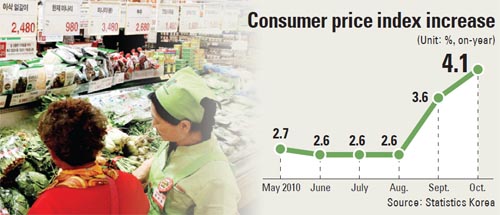Produce, fish prices jumped 49% in October

Overall prices of fresh produce and fish jumped 49.4 percent from a year before, the biggest rise since 1990 when the government started compiling the data, a government report said yesterday.
To deal with inflationary pressure, the government said yesterday that it intends to expand agricultural supplies by allowing a higher volume of imported goods, including garlic, chili peppers and radishes. The price of gas for cooking and heating was lowered yesterday and liquefied petroleum gas prices will also be reduced.
According to Statistics Korea, the consumer price index shot up 4.1 percent last month from a year before. This is the fastest increase since February 2009 when the index rose by the same figure. The index went up 0.2 percent from September.
The rise was largely attributed to the soaring price of Napa cabbage, which leaped 261.5 percent in October from a year earlier. Radish prices jumped even higher at 275.7 percent, followed by green onions (145.5 percent), tomatoes (115.4 percent) and garlic (102.5 percent).
The government said produce and fish prices were on the decline and overall inflation for the year would not exceed 3 percent.
The retail price of Napa cabbage, the main ingredient in kimchi, started climbing from 6,664 won ($6) on Sept. 15 to 7,184 won on Sept. 20, then to 10,425 won on Oct. 5 before falling to 3,770 won on Oct. 22.
“If the prices of vegetables continue to decline, consumer prices are going to fall this month,” Lee Eok-won, a director of the price policy team at the Ministry of Strategy and Finance, said in a statement.
“Fast economic recovery in the first half of the year led to increases in employment and household income, and this resulted in growing consumer demand,” Deputy Finance Minister Kang Ho-in said, explaining the price hikes. “If inflation falls to around 3 percent in November and December, the overall rate of inflation for the year is likely to be about 3 percent, or even below.”
However, the sharp gain in consumer prices last month is still expected to put pressure on the central bank to consider an interest rate increase when its policy makers meet on Nov. 16.
The Bank of Korea is aiming for a median inflation target of 3 percent with a margin of plus or minus 1 percentage point between 2010 and 2012.
The central bank froze the interest rate at 2.25 percent for the third straight month in October because of the slowing global economic recovery and the local currency’s gain against the dollar.
Meanwhile, the government plans to raise imports of garlic, peppers, onions and radishes and cut tariffs on mackerel and walleye pollock to stabilize prices.
The price of gas for heating and cooking was lowered 4.9 percent yesterday. The price of LPG will be cut by around 1 percent in November.
By Limb Jae-un [jbiz91@joongang.co.kr]










with the Korea JoongAng Daily
To write comments, please log in to one of the accounts.
Standards Board Policy (0/250자)